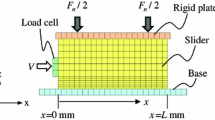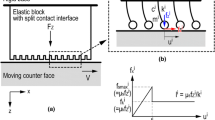Abstract
Here, we present a mass-less quasi-static model of stick-slip phenomenon built exclusively on the difference between higher static and lower kinetic friction force. The model allows explaining the disappearance of stick-slip motion when elastic surface slid in contact with rigid counter-face bears large amount of small outgrowths. Adjusting the model parameters, it is also possible simulating systems with different transient responses. The results obtained may also be helpful in understanding the variety of sliding behavior of different materials.



Similar content being viewed by others
References
Scholz, C.H.: Earthquakes and friction laws. Nature 391, 37–42 (1998)
Mo, Y., Turner, K.T., Szlufarska, I.: Friction laws at the nanoscale. Nature 457, 1116–1119 (2009)
Moore, D.F.: Principles and Applications of Tribology. Pergamon, Oxford (1975)
Dowson, D.: History of tribology, 3rd edn. Wiley, Chicester (2013)
Rabinowicz, E.: The intrinsic variables affecting the stick-slip process. Proc. Phys. Soc. Lond. 71, 668–675 (1958)
Rubinstein, S.M., Cohen, G., Fineberg, J.: Detachment fronts and the onset of dynamic friction. Nature 430, 1005–1009 (2004)
Xia, K.W., Rosakis, A.J., Kanamori, H.: Laboratory earthquakes: the sub-Rayleigh-to-supershear rupture transition. Science 303, 1859–1861 (2004)
Rubinstein, S.M., Cohen, G., Fineberg, J.: The dynamics of precursors to frictional sliding. Phys. Rev. Lett. 98, 226103 (2007)
Yang, Z.P., Zhang, H.P., Marder, M.: Dynamics of static friction between steel and silicon. Proc. Natl. Acad. Sci. U.S.A. 105, 13264–13268 (2008)
Ben-David, O., Rubinstein, S.M., Fineberg, J.: Slip-stick: the evolution of frictional strength. Nature 463, 76–79 (2010)
Ben-David, O., Cohen, G., Fineberg, J.: The dynamics of the onset of frictional slip. Science 330, 211–214 (2010)
Ben-David, O., Fineberg, J.: Static friction coefficient is not a material constant. Phys. Rev. Lett. 106, 254301 (2011)
Capozza, R., Rubinstein, S.M., Barel, I., Urbakh, M., Fineberg, J.: Stabilizing stick-slip friction. Phys. Rev. Lett. 107, 024301 (2011)
Bennewitz, R., David, J., de Lannoy, C.-F., Drevniok, B., Hubbard-Davis, P., Miura, T., Trichtchenko, O.: Dynamic strain measurements in a sliding microstructured contact. J. Phys. Condens. Mat. 20, 015004 (2008)
Heywood, J.B.: Internal combustion engine fundamentals. McGraw-Hill, New York (1988)
Beutel, R.G., Gorb, S.N.: Ultrastructure of attachment specializations of Hexapods (Arthropoda): evolutionary patterns inferred from a revised ordinal phylogeny. J. Zool. Syst. Evol. Res. 39, 177–207 (2001)
Autumn, K., Liang, Y.A., Hsieh, S.T., Zesch, W., Chan, W.P., Kenny, T.W., Fearing, R., Full, R.J.: Adhesive force of a single gecko foot-hair. Nature 405, 681–685 (2000)
Geim, A.K., Dubonos, S.V., Grigorieva, I.V., Novoselov, K.S., Zhukov, A.A., Shapoval, S.Y.: Microfabricated adhesive mimicking gecko foot-hair. Nat. Mater. 2, 461–463 (2003)
Peattie, A.M., Full, R.J.: Phylogenetic analysis of the scaling of wet and dry biological fibrillar adhesives. Proc. Natl. Acad. Sci. U.S.A. 104, 18595–18600 (2007)
Varenberg, M., Murarash, B., Kligerman, Y., Gorb, S.N.: Geometry-controlled adhesion: revisiting the contact splitting hypothesis. Appl. Phys. A 103, 933–938 (2011)
Schallamach, A.: How does rubber slide? Wear 17, 301–312 (1971)
Varenberg, M., Gorb, S.: Shearing of fibrillar adhesive microstructure: friction and shear-related changes in pull-off force. J. R. Soc. Interface 4, 721–725 (2007)
Varenberg, M., Gorb, S.: Hexagonal surface micropattern for dry and wet friction. Adv. Mater. 21, 483–486 (2009)
Rand, C.J., Crosby, A.J.: Friction of soft elastomeric wrinkled surfaces. Appl. Phys. Lett. 106, 064913 (2009)
Murarash, B., Itovich, Y., Varenberg, M.: Tuning elastomer friction by hexagonal surface patterning. Soft Matter 7, 5553–5557 (2011)
Brormann, K., Barel, I., Urbakh, M., Bennewitz, R.: Friction on a microstructured elastomer surface. Tribol. Lett. 50, 3–15 (2013)
Lorenz, B., Persson, B.N.J.: On the origin of why static or breakloose friction is larger than kinetic friction, and how to reduce it: the role of aging, elasticity and sequential interfacial slip. J. Phys. Condens. Mat. 24, 225008 (2012)
Zakharov, V.S.: Models of seismotectonic systems with dry friction. Mosc. Univ. Geol. Bull. 66, 13–20 (2011)
Burridge, R., Knopoff, L.: Model and theoretical seismicity. Bull. Seismol. Soc. Am. 57, 341–371 (1967)
Carlson, J.M., Langer, J.M.: Properties of earthquakes generated by fault dynamics. Phys. Rev. Lett. 62, 2632–2635 (1989)
Olami, Z., Feder, H.J.S., Christensen, K.: Self-organized criticality in a continuous, nonconservative cellular automaton modeling earthquakes. Phys. Rev. Lett. 68, 1244–1247 (1992)
Persson, B.N.J.: Theory of friction: stress domains, relaxation, and creep. Phys. Rev. B. 51, 13568–13585 (1995)
Braun, O.M., Barel, I., Urbakh, M.: Dynamics of transition from static to kinetic friction. Phys. Rev. Lett. 103, 194301 (2009)
Tromborg, J., Scheibert, J., Amundsen, D.S., Thogersen, K., Malthe-Sorenssen, A.: Transition from static to kinetic friction: insights from a 2D model. Phys. Rev. Lett. 107, 074301 (2011)
Akishin, P.G., Altaisky, M.V., Antoniou, I., Budnik, A.D., Ivanov, V.V.: Burridge-Knopoff model and self-similarity. Chaos Soliton. Fract. 11, 207–222 (2000)
Bhushan, B.: Introduction to tribology, p. 208. Wiley, New York (2002)
Dyson, J., Hirst, W.: The true contact area between solids. P. Phys. Soc. B 67, 309–312 (1954)
Persson, B.N.J.: On the theory of rubber friction. Surf. Sci. 401, 445–454 (1998)
Acknowledgments
We acknowledge the support of the Israel Science Foundation (Grant No. 314/12).
Author information
Authors and Affiliations
Corresponding author
Rights and permissions
About this article
Cite this article
Kligerman, Y., Varenberg, M. Elimination of Stick-Slip Motion in Sliding of Split or Rough Surface. Tribol Lett 53, 395–399 (2014). https://doi.org/10.1007/s11249-013-0278-8
Received:
Accepted:
Published:
Issue Date:
DOI: https://doi.org/10.1007/s11249-013-0278-8




